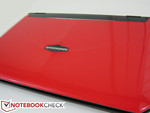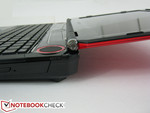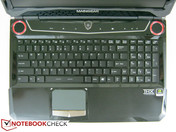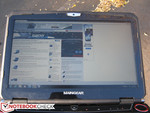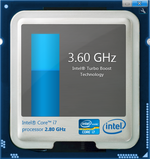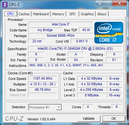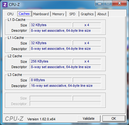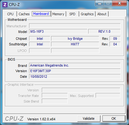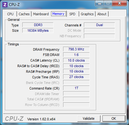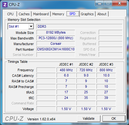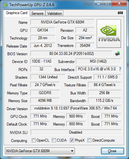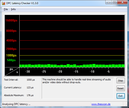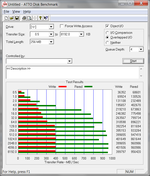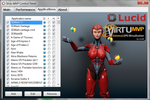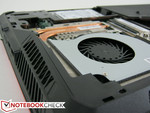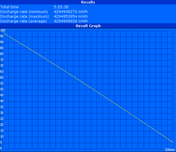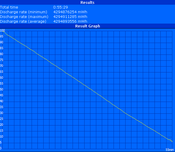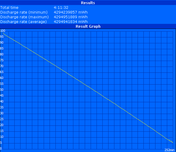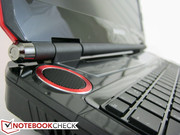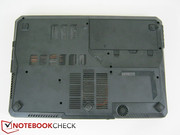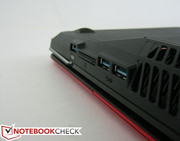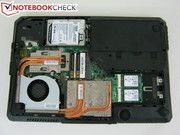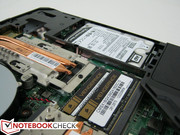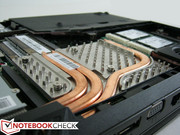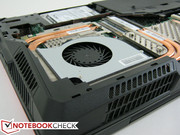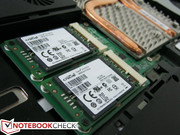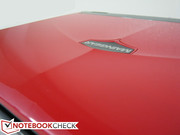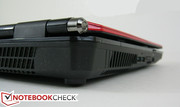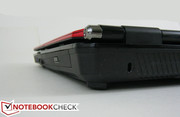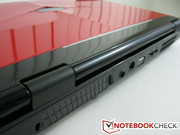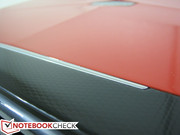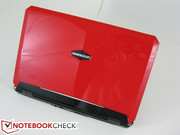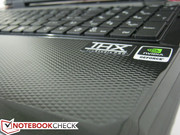Review Maingear Nomad 15 Notebook

In the desktop replacement market, whitebooks and barebones are popular choices for the easy customization and wide component compatibility that their hardware sets tend to offer. Popular examples are the Clevo barebones used by numerous resellers and system builders such as XMG, Eurocom, iBUYPOWER and Sager. While many Clevo products have been reviewed here, they also all have a tendency to look similar and very basic. Especially considering the high prices, users may be expecting some appreciative aesthetics to accentuate the hardware power without the gaudy and sometimes excessive spectacle of the Alienware brands.
The U.S.-based system builder and reseller Maingear attempts to hit a note in between while providing just as much power as other DTRs. Though the manufacturer continues to specialize in desktops and government solutions, their custom gaming notebooks are a relatively newer venture and are only now beginning to seriously push their mobile products.
In this review, we take a closer look at the Nomad 15, Maingear’s latest 15.6-inch incarnation built upon an MSI-based shell. More specifically, the chassis is near-identical to that of our reviewed MSI GT60/GX60 which we highly recommend reading due to the similarities. The notebook as reviewed includes almost all the bells and whistles: a Core i7-3840QM, GeForce GTX 680M with a massive 4 GB VRAM, 16 GB DDR3-1600 RAM and a pair of 128 GB Crucial m4 mSATA drives in stripe formation. The system will run users about $2599 as customized, though the system can be had for only $1549 with mainstream options. The following review takes a closer look at the aesthetics and hardware performance to see if it holds up against the current crop of high-end gaming notebooks and competing DTRs.
Case
As a system builder, Maingear utilizes an MSI barebones for the Nomad 15. Unlike a number of resellers, however, the manufacturer does a bit more than just slap on a logo after assembling the hardware. The lid has been specially painted by automotive experts to resemble the sheen of a luxury car and all system integration is done in-house. The curvatures and polishing work are especially sleek and contrast well to the usually flat and sometimes lifeless covers of other DTRs. Elsewhere on the notebook, the textured honeycomb surface dominates the palm rests and the hardened underside is tough enough to resist significant warping while providing easy access to the internals. The unique surfaces and thick build do well to hide the fact that the chassis is still plastic at its core, though the overall quality is superb all-around with looks that sway more towards an agreeable glossiness than something overly bright and extravagant.
Surface depressions are minimal both down the lid and on the center of the keyboard where notebooks are usually weakest. These areas still depress when a fair amount of pressure is applied, but never by a worrying degree. The same is also true when twisting the lid and base side-to-side as both demonstrate good resistance. The small dual hinges are stiff enough to hold the lid firmly and without vibrations during heavy typing or button-mashing. The chassis is definitely well-built and genuinely reflects the high price of entry.
At a listed 7.7 pounds (3.5 kg), the Nomad 15 is identical to the MSI GT60 in weight with nearly the same dimensions. However, This also means that the Maingear DTR is noticeably larger and heavier than many of our tested 15.6-inch Clevo units including the W150ER, W350ET, and P150EM by up to 1 kg, the latter of which houses the competing Radeon HD 7970M. To most stationary DTR users, the additional mass is of little concern and can be considered a testament to the high stability of the unit.
Connectivity
Port selection is in line with other 15.6-inch gaming notebooks and is once again identical to that of the GT60. While the extensive audio support (7.1 and 5.1 surround, 2.1, S/PDIF) is welcomed, the positioning of the ports is less favorable as right-handed mouse users will be sharing valuable space with potentially bothersome cables. Still, the Nomad 15 provides all the essentials for gamers and heavy users alike.
Communication
Whereas GPS and WWAN radios can be crucial for ultraportables, they are less of an importance for most gaming notebooks. This has allowed DTR manufacturers to throw in higher-end WLAN adapters as standard and focus on features for improving local connectivity. Maingear includes the dual-band (2.4 GHz and 5.0 GHz) 2x2 Intel Advanced-N 6230 Half Mini card with Bluetooth 4.0 across all models. Those with wireless networks that can support 3x3 tri-streaming can benefit from the Atheros Killer 1103 adapter upgrade for up to 50 percent wider throughput, otherwise the base Intel adapter should suffice for most users.
Warranty
Maingear offers the basic 1-year comprehensive warranty with every purchase and can be expanded up to 3 years for $259. Shipping will also be prepaid should the user run into unexpected problems during the first 30 days of use. A 30-day zero dead pixel guarantee is available as well, but will run users another $85 at checkout. Unique to the manufacturer is their Angelic Service Labor support, which includes remote desktop services and telephone support for the lifetime of the product.
Input Devices
Keyboard
The large backlit Chiclet keyboard (35 cm x 10.5 cm) is the same as it appeared on our GT60 unit and thus functions and feels similarly as well. Keys are spacious with excellent travel and responsiveness that should suit the hardcore gamer almost as well as can a full-size desktop keyboard. There is nothing fancy or needlessly colorful about the layout to cater to gamers, but the removal of the Windows key from the left hand side is a boon to WASD-based games and other keyboard-heavy titles.
Some of the same problems form the GT60 have carried over to the keyboard of the Nomad 15. The touch-based controls (Turbo, backlight, and fan control) adjacent to the power button don't respond reliably when touched and some users may be irked about the half-sized “0” key on the numpad. Not-picking aside, the core functionality of the keyboard remains top-notch.
Touchpad
The flat and slightly roughened touchpad is small in size (8.0 cm x 5.0 cm) but very firm and well-made compared to other DTRs. We fortunately experienced no cursor issues as we did on the GT60 as the Synaptics v7.5 software was able to handle both single- and multi-touch inputs reliably. Note, however, that the low surface area naturally makes zooming more difficult than it should be.
The left and right click keys are brushed with a metallic sheen and elevated slightly for improved ergonomics. Both keys are very shallow in depth and quiet when pushed, but the solid feedback and inflexibility make up for the lack of travel. The additional LED indicators immediately below is a nice feature if not a bit redundant as some are already indicated adjacent to the power button. The touchpad as a whole gets the job done without problems, but most users will of course use dedicated mice whenever possible.
Display
When a system is running on something as powerful as a GTX 680M, then the display must be equally as impressive in order to take advantage of all the eye candy the Nvidia card can offer. The Nomad 15 comes pre-loaded with a 1080p matte display and, according to the panel ID (LP156WF1-TLF3), is the same display model as the one found in our MSI GT60 review unit. Subjectively, images appear sharp with rich color and free of obvious grains commonly found on cheaper, lower resolution displays.
| |||||||||||||||||||||||||
Brightness Distribution: 78 %
Center on Battery: 254 cd/m²
Contrast: 600:1 (Black: 0.44 cd/m²)
60.2% AdobeRGB 1998 (Argyll 3D)
86.2% sRGB (Argyll 3D)
58.1% Display P3 (Argyll 3D)
Despite the similar display panel, we have recorded slightly different luminance values with the Gossen Mavo-Monitor. The average maximum brightness of about 230 nits is a tad lower than what we recorded on the MSI GT60 while the contrast ratio is improved due to the lower black levels. Nonetheless, the differences are quite minor and do not detract from the quality of the display.
The reproducible color space is, as expected, essentially the same as the MSI GT60 and makes up almost 90 percent of sRGB or about 30 percent more coverage than budget TN displays. This is more than satisfactory for gaming purposes and may even be enough for amateur digital graphic artists where accurate colors are vital. Though very good, the spectrum does not satisfy AdobeRGB standards and pales when compared to high-end workstations where color accuracy can be paramount (such as the ThinkPad W530). To the target audience, this is certainly a non-issue.
Outdoor usability is acceptable when at maximum brightness as the matte surface aids greatly in reducing almost all reflections. The notebook becomes more difficult to use under direct sunlight as the backlight is simply not powerful enough to overcome the ambient conditions, so spots with shade or otherwise cloudy days are preferable. Users can take advantage of the full brightness potential as maximum brightness does not automatically scale down if on lower power profiles. If need be, the Nomad 15 can generally be used outdoors without major visibility frustrations.
Performance
The manufacturer offers only two CPU options with its Nomad 15 and both are more than enough to fulfill the needs of any current or near-future titles to come. Users can choose between the high-end 2.7 GHz Core i7-3740QM or 2.8 GHz Core i7-3840QM with the only major difference between them being a 100 MHz difference in both clock rates and Turbo Boost potential. Otherwise, the two 22 nm quad-core Ivy Bridge processors are each rated for a 45 W TDP with completely identical cache sizes. For more information and benchmarks on the I7-3840QM, see our dedicated page here.
The now ubiquitous Intel HD 4000 GPU is paired with the Ivy Bridge core and operates here at a base 650 MHz speed with a 350 MHz idle. The integrated GPU is not the focus of this review and further details and benchmarks can be seen on our dedicated review page here.
For RAM, the reviewed model is equipped with 2x 8 GB Corsair Vengeance modules for a total of 16 GB. The two modules are accessed via the easily removable hatch underneath the notebook while two additional modules can be added only after disconnecting and removing the keyboard.
DPC Latency Checker returned no high latency peaks even with all wireless radios active.
Processor
In the synthetic CPU-oriented benchmarks, the i7-3840QM in the Nomad 15 produced similar numbers when compared to another notebook sporting the same CPU, the M73-2N barebones. Results from the single-threaded application Super Pi stood out in particular as the CPU rivals that of the i7-3940XM in raw speed, which is currently the fastest Ivy Bridge quad-core CPU currently available. The very similar single-core Turbo Boost clock rate between the two CPUs (3.7 GHz vs 3.8 GHz) explains the similar numbers.
Compared to other CPUs of its class such as the i7-3820QM and i7-3740QM, the 3840QM shows marginal improvement in both CineBench and wPrime and completes the X264 HD Benchmark encoding process in indistinguishable time frames. As such, users who opt for the “lower-end” i7-3740QM in the Nomad 15 will certainly not be missing any tangible performance benefits from users with the more expensive CPU option.
| Cinebench R10 | |
| Rendering Single CPUs 64Bit (sort by value) | |
| Maingear Nomad 15 | |
| Alienware M18x R2 | |
| Deviltech HellMachine | |
| Rendering Multiple CPUs 64Bit (sort by value) | |
| Maingear Nomad 15 | |
| Alienware M18x R2 | |
| Deviltech HellMachine | |
System Performance
With PCMark 7 and PCMark Vantage, the notebook produced extremely high final scores of 5321 and 21663, respectively, no doubt aided by its dual SATA III solid-state drives in RAID 0. This puts the Nomad 15 in the same ballpark as some of the heaviest hitters on Notebookcheck, including the XMG P722 Pro with its GTX 680M SLI and the Alienware M18x R2 with its Radeon HD 7970M in CrossFire configuration. The system performance and responsiveness of the Maingear is one of the best in the high-end gaming sector.
| PCMark Vantage Result | 21663 points | |
| PCMark 7 Score | 5321 points | |
Help | ||
Storage Devices
Maingear offers a very wide selection of storage options since the system is able to house a 2.5-inch SATA drive and up to two other mSATA drives with support for RAID 0 or 1. Gamers and performance hunters will typically prefer RAID 0 and our system in review is equipped with dual 6 Gb/s 128 GB Crucial M4 mSATA drives in such a configuration. The relatively low capacity of the SSDs is mitigated by the addition of a 7200 RPM 750 GB 2.5-inch Western Digital Scorpio drive on a SATA II interface.
In terms of sequential read performance, the dual Crucial drives is roughly over three times faster than a single SATA II SSD and about twice as fast as a single SATA III SSD. 4K read/write speeds, however, continue to be the usual weak spot for non-mechanical drives and the RAID setup does little to help as even the single ADATA MX11 SSD in the Zenbook UX31A returned similar 4K results in CrystalDiskMark. The sequential write speeds of the striped Crucial drives are also well below the Lite-On RAID 0 array as found in our recently reviewed Acer Aspire S7 by almost half and is even slower than the single Lite-On drive in the Samsung Series 9 900X3C. Subjectively, however, most users will hardly notice any slowdowns or delays while running applications and games.
Gaming Performance
While the unit can be pre-configured with the base GTX 670MX, our model includes a GTX 680M with a ridiculously high 4 GB of GDDR5 VRAM. With so much RAM under the hood, most memory-heavy graphics options (such as textures and supersampling) can be bumped to the maximum without too large of a performance hit. The Nvidia GPU runs at only 135 MHz and 162 MHz on its core and memory, respective, when idling. Additional information and benchmarks on this premier mobile Kepler core can be seen on our dedicated GPU page here. Nvidia fans can rejoice that the 680M does not suffer from any graphics switching problems as does the Radeon HD 7970M in our comparison review.
The raw performance in synthetic benchmarks is remarkable. With a final 3DMark 11 score of 7218, the Nomad 15 outscores all our previously tested notebooks with the same GTX 680M GPU by over 1000 points. This includes our tested Eurocom Racer 2.0 and its HD 7970M GPU as well. The notebook also maintains this lead in previous 3DMark versions including 06, 05 and 03. In comparison, the Clevo P570WM and its 680M SLI setup managed 10292 in 3DMark 11, or about 43 percent higher than the Maingear in review. Nomad 15 users will certainly benefit from the Nvidia GPU to its fullest.
The boost in scores can be attributed to the Virtu MVP software, which has only recently begun appearing on notebooks with Maingear as one of the early adopters of the technology. The proprietary software utilizes the iGPU (the HD 4000 in this case) in conjunction with the dGPU to remove screen tearing up to 120 FPS. Called Virtual Vsync, this allows users to play at very high frame rates above the native refresh rate of the monitor with no screen tearing should the dGPU be powerful enough to render 60+ FPS. The natural side effect of the high frames is improved responsiveness from user inputs for more precise gameplay.
In Deux Ex, we experienced average frame rates of 93 FPS and 187 FPS when benchmarking without Virtu MVP and with Virtu MVP, respectively. Skyrim enjoyed a similar bump in performance from about 52 FPS to 87 FPS. For the majority of titles, however, the software does little in boosting perceptible frame rate performance as the benchmark numbers below show no considerable differences when compared to our other GTX 680M-equipped notebooks. Virtu MVP is still in its infancy and its games support list is still growing, but its prospects and early assessments have been promising so far. We fortunately ran into no performance hits or crashes by leaving the software active and in parallel with Nvidia Optimus, but users can always disable the software if so desired.
| 3DMark 03 Standard | 72750 points | |
| 3DMark 05 Standard | 32763 points | |
| 3DMark 06 Standard Score | 25378 points | |
| 3DMark Vantage P Result | 19575 points | |
| 3DMark 11 Performance | 7218 points | |
Help | ||
| low | med. | high | ultra | |
|---|---|---|---|---|
| Metro 2033 (2010) | 24 | |||
| StarCraft 2 (2010) | 119 | |||
| Deus Ex Human Revolution (2011) | 187 | |||
| Battlefield 3 (2011) | 39 | |||
| The Elder Scrolls V: Skyrim (2011) | 87 | |||
| Alan Wake (2012) | 45 | |||
| Diablo III (2012) | 240 | |||
| Darksiders II (2012) | 69 | |||
| Sleeping Dogs (2012) | 24 | |||
| Guild Wars 2 (2012) | 31 | |||
| F1 2012 (2012) | 65 | |||
| Borderlands 2 (2012) | 74 | |||
| Dishonored (2012) | 111 |
Emissions
System Noise
While a number of gaming notebooks may utilize multiple cooling fans for the power-hungry CPU and GPU, Maingear has opted for a large single fan with dual-heatsink solution which they claim produces less noise than multiple smaller fans. While this is debatable, one thing is certain: the fan here never stops spinning and is always audible no matter the current power setting.
When idling and under the Power Saver setting with integrated graphics active, we recorded fan noise of almost 40 dB(A). Such a level is common for more typical notebooks when under full stress, but here it is for a notebook sitting idle. Other notebooks, such as the 17.3-inch Alienware M17x R4 and certain Clevo units, have idle noise levels that are much lower and closer to the more acceptable 30 dB(A) range. Only the recently reviewed 17.3-inch Clevo P570WM with its dual GTX 680M GPUs comes close to matching the idle noise of the Nomad 15 at a measured average of 38 dB(A). Standard browsing and simple multitasking are fortunately not enough to bump up fan speeds, so users who are simply checking mail or browsing Youtube will likely not hear anything louder than the system’s already loud idling noise.
Launch any 3D game or CPU-intensive application and the fan will instantly jump to about 45 dB(A) and then level off at a very high 51 dB(A) if under full stress. If the GPU reaches 80 degrees C or if the user enables maximum fan speed, the system becomes even louder at a measured 55.8 dB(A) until the major components have cooled. The 50 dB(A) range is impossible to ignore while gaming unless if the user is wearing earphones or headphones. However, the high noise when under load is typical of high-end gaming notebooks and should be of no surprise to gamers.
Noise level
| Idle |
| 39.4 / 39.8 / 39.9 dB(A) |
| DVD |
| 42.2 / 44.4 dB(A) |
| Load |
| 45.8 / 51 dB(A) |
 | ||
30 dB silent 40 dB(A) audible 50 dB(A) loud |
||
min: | ||
Temperature
The high fan speeds and noise may have paid off with regards to surface temperature as the system does an excellent job at keeping most areas very cool. Idling temperatures average about 25 degrees C on all nine quadrants of both the underside and keyboard area under cold 21 degrees C ambient conditions.
Under maximum load, surfaces on both sides remained cool to warm except for the obvious hotspot on the quadrant closest to the only two vents on the system. These results are similar to the reviewed GT60 because the important areas, such as the palm rests, touchpad, and keyboard, do not heat up by a significant amount for maximum user comfort during intense gameplay. Most high-end gaming notebooks, notably the Alienware and Clevo-based brands, tend to have steadier temperature gradients under load instead of the steep drop as measured here on the Nomad 15. The system dissipates the concentrated heat very efficiently and will certainly heat up anything in the immediate vicinity of the corner vents.
Our temperature measurements were done after one full hour of full stress with both Prime95 and FurMark. Most users will experience much lower temperatures under more typical usage.
(+) The maximum temperature on the upper side is 36.2 °C / 97 F, compared to the average of 40.4 °C / 105 F, ranging from 21.2 to 68.8 °C for the class Gaming.
(-) The bottom heats up to a maximum of 52 °C / 126 F, compared to the average of 43.3 °C / 110 F
(+) In idle usage, the average temperature for the upper side is 25.2 °C / 77 F, compared to the device average of 33.9 °C / 93 F.
(+) The palmrests and touchpad are cooler than skin temperature with a maximum of 25.8 °C / 78.4 F and are therefore cool to the touch.
(+) The average temperature of the palmrest area of similar devices was 28.9 °C / 84 F (+3.1 °C / 5.6 F).
Stress Test
We utilized Prime95 and FurMark to both stress the notebook and to observe system stability with HWiNFO, CPU-Z, and GPU-Z.
CPU stress was accomplished first with Prime95 where all four cores stabilized at 3.2 GHz, or well below the 3.6 GHz Turbo Boost promised by the i7-3840QM CPU. The cores were only able to maintain the 3.6 GHz speed for only under a couple of minutes before dropping to a constant 3.2 GHz after CPU temperature reached 94 degrees C.
With FurMark for GPU stress, the GTX 680M had no problems maintaining a core clock of 757 MHz (or 770 MHz with Turbo) and memory clock of 900 MHz, respectively, according to GPU-Z. The 680M does not feature GPU Boost as does its desktop variants, but it never downclocked during the test and was able to run at maximum load throughout.
When under full stress for over an hour, the CPU cores throttled to 1200 MHz and would only periodically return to its base 2800 MHz speed lasting for just a few seconds. Temperatures never climbed above 94 degrees C. The GPU fared much better and was able to maintain its clock rates at a stable 85 degrees C. GPU load occasionally dropped according to GPU-Z, hinting at the possibility that the notebook simply cannot provide enough power to run both the demanding GPU and CPU at maximum speeds for extended periods.
Fortunately, most users will likely not experience the throttling issues during real-world applications or gameplay. The 3DMark 06 scores immediately following the end of the test returned numbers very similar to the first 3DMark 06 run prior to stress testing, confirming little or at least insubstantial impact to overall performance during heavy use. Repeating the 3DMark 06 benchmark on battery power did affect the final score rather dramatically (14674 points vs. 25646 points).
Speakers
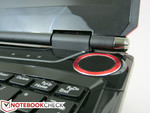
The red-chromed speakers and lone subwoofer underneath from Dynaudio are very loud at maximum volume and provide excellent audio for music and movies or otherwise. Bass and other low key instruments that can be inperceptible on budget notebooks are at least audible here, but there is slight distortion if the volume is set too loudly. Dedicated external speaker systems continue to provide a better experience if available, though we had no complaints growing accustomed to the built-in setup either. It would have also been convenient to include dedicated volume controls as are common amongst multimedia notebooks. Like many other extreme gaming notebooks, the Nomad 15 does provide multiple 3.5 mm audio ports and options for the user.
Battery Life
The Nomad 15 uses a 7800 mAh removable battery, a relatively dense module even by 15.6-inch gaming standards. Our reviewed Clevo W150ER only included a 5600 mAh battery and the even larger DevilTech HellMachine and Clevo P570WM both use batteries in the 5000 mAh range as well.
Maximum battery life was tested with the Reader’s Test under Battery Eater at minimum brightness and in Power Saver mode while minimum battery life was tested with the Classic Test at maximum brightness and in Performance mode. When combined with Optimus, the Nomad 15 was able to last for almost 5 hours 30 minutes in our test, which is very respectable considering its hardware class.
Our more realistic WLAN test puts the machine on Balanced and the screen at 150 cd/m2 whilst running our standard browsing script to simulate typical browsing conditions. At over 4 hours of runtime, the Nomad 15 offers longer battery life than the majority of high-end DTRs. The similarly sized Clevo W350ET with its less powerful GTX 660M and 7800 mAh battery edges out the Nomad 15 by only a mere few minutes.
Verdict
Though relatively new to the DTR segment, Maingear has impressed us with its personal take on an MSI gaming chassis. Visually, the well-built case is less boxy and more stylish than its Clevo competitors and the custom-painted lid distinctly separates the Nomad 15 from Alienware models and the typically dull barebone units.
System performance is outstanding and beyond what we expected as PCMark benchmarks place it in the same league as certain SLI and CrossFire systems due in part to the mSATA SSD RAID 0 configuration and the Virtu MVP software. Battery life is also very good considering the thirsty power hogs under the hood and the surface temperatures are even more astonishing for a system with only a single fan. The Nomad 15 strikes a near-perfect balance between aesthetics and overall performance.
A few rough spots do hold back the notebook from being the ultimate all-rounder gaming machine. The largest factor is the unavoidable high fan noise, which is louder than most DTRs even when idle. This alone can be irksome during light tasks such as browsing or streaming video and music. Secondly, weight and girth are also heftier than similarly sized Clevo units. Fortunately, these two drawbacks are usually of least concern for gamers looking for a high-end notebook and, realistically, should be expected to some degree. We did experience throttling during the stress test, but our standard stress conditions do not portray everyday use and we observed no perceptible impact on everyday performance or gaming.
The Nomad 15 is the powerhouse that one might come to expect from a DTR, but with enough options that even the entry-level $1549 can be worthwhile due to easy expandability and especially the potential of a future SSD RAID 0 upgrade.
In Comparison
| Metro 2033 - 1920x1080 Very High DX11 AA:A AF:4x (sort by value) | |
| Maingear Nomad 15 | |
| Deviltech Devil 6700 | |
| Alienware M17x R4 | |
| Battlefield 3 - 1920x1080 ultra AA:4x MS AF:16x (sort by value) | |
| Maingear Nomad 15 | |
| Deviltech HellMachine | |
| Deviltech Devil 6700 | |
| Alienware M17x R4 | |
| The Elder Scrolls V: Skyrim - 1920x1080 Ultra Preset AA:8x AF:16x (sort by value) | |
| Maingear Nomad 15 | |
| Deviltech HellMachine | |
| Deviltech Devil 6700 | |
| Alienware M17x R4 | |
| Sleeping Dogs - 1920x1080 Extreme Preset AA:Extreme (sort by value) | |
| Maingear Nomad 15 | |
| Deviltech HellMachine | |
| Schenker XMG P502 | |
| Guild Wars 2 - 1920x1080 All Maximum / On AA:FX (sort by value) | |
| Maingear Nomad 15 | |
| Deviltech HellMachine | |
| Schenker XMG P502 | |
| Deus Ex Human Revolution - 1920x1080 DX11, Soft Shadows, SSAO High, DOF: High, Post Processing, Tessellation AA:ML AF:16x (sort by value) | |
| Maingear Nomad 15 | |
| Deviltech Devil 6700 | |
| Alienware M17x R4 | |
| Borderlands 2 - 1920x1080 (Ultra) High / On (PhysX low) AA:FX AF:8x (sort by value) | |
| Maingear Nomad 15 | |
| Deviltech HellMachine | |
| Schenker XMG P502 | |
| F1 2012 - 1920x1080 Ultra Preset AA:4xMS (sort by value) | |
| Maingear Nomad 15 | |
| Deviltech HellMachine | |
| Schenker XMG P502 | |




